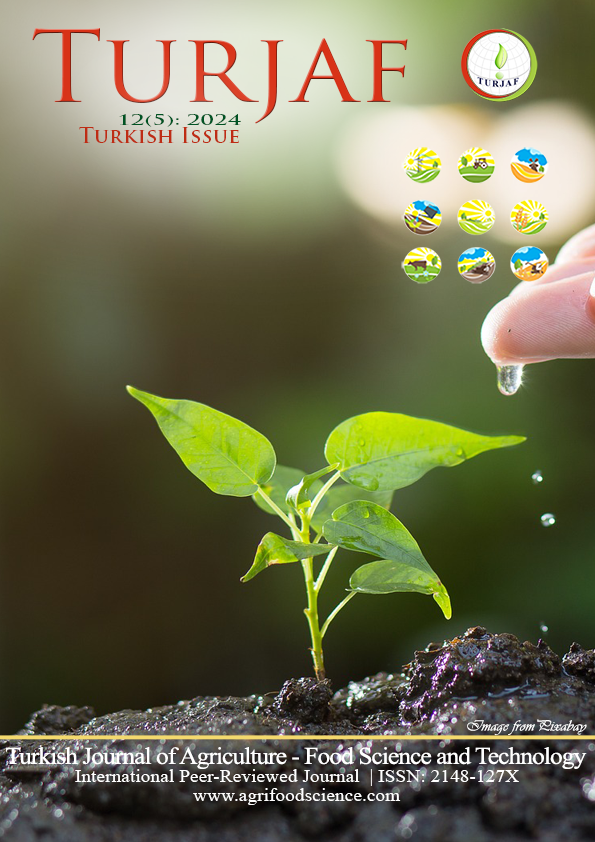A Research on Determining the Attitudes of Consumers Living in the Black Sea Region Towards Hazelnut
DOI:
https://doi.org/10.24925/turjaf.v12i5.786-794.6813Keywords:
Hazelnut, Attitude, Attitude towards hazelnut, Consumer behavior, Black Sea RegionAbstract
This study aims to determine the attitudes of consumers living in the Black Sea Region towards hazelnut. The study has also tried to determine whether the attitudes of the participants towards hazelnuts differ according to their demographic characteristics. The population of the research consists of people between the ages of 18-65 living in the Black Sea Region. The sample consists of 384 people who were selected by convenience sampling method and voluntarily participated in the research. Descriptive statistical analysis, exploratory factor analysis, t-test and Anova tests were used to analyze the data. It was observed that the majority of the consumers in the research area consume hazelnuts in the form of half a handful of natural hazelnuts in the evening meals, usually 2-3 times a week. As a result of the factor analysis conducted to measure consumers' attitudes towards hazelnuts, four sub-dimensions were obtained: health, culture, happiness and flavor. It was determined that the averages of all sub-dimensions of the attitudes towards hazelnut scale, except for the flavor sub-dimension, differed according to some demographic characteristics of consumers. It was observed that the happiness sub-dimension was more important in the attitudes of single and male consumers towards hazelnuts than married and female consumers. It was concluded that the health sub-dimension is more important in consumers' attitudes towards hazelnuts as the age and education level increases. It is thought that the findings obtained as a result of this study will be useful in terms of guiding people by addressing the living standards of hazelnut consumers on the axis of healthy life and psychological happiness.
References
Anonim, (2024a). Çiğ fındığın inanılmaz 10 faydası. https://www.meraklilar.com.tr/cig-findigin-inanilmaz-10-faydasi (Erişim tarihi: 08.04.2024).
Anonim, (2024b). Food and Agriculture Organization of the United Nations, Statistics Division (FAOSTAT). Online FAO databank. http://www.fao.org/. (Erişim tarihi: 07.04.2024).
Anonim, (2024c). Türkiye İstatistik Kurumu (TÜİK). https://www.tuik.gov.tr/ (Erişim tarihi: 27.03.2024).
Büyüköztürk, Ş., Çokluk, Ö. & Köklü, N. (2018). Sosyal bilimler için istatistik. Ankara: Pegem Akademi Yayınları. Doi:10.14527/9789756802335
Field, A. (2000). Discovering Statistics using SPSS for Windows. London, Thousand Oaks, Sage Publications, New Delhi.
İçöz, E. (2021). Gençlerin çikolata tüketiminde tercihleri üzerine bir alan araştırması (Yayımlanmamış yüksek lisans tezi). İstanbul Ayvansaray Üniversitesi Lisansüstü Eğitim Enstitüsü, İstanbul
İslam, A. (2018). Hazelnut culture in Turkey. Akademik Ziraat Dergisi, 7(2), 259-266
Narin, Ö. (2019). Doğu Karadeniz Bölgesinde fındık üreticilerinin durumu ve üretici kooperatifi olanakları üzerine. İçinde, İktisadi ve İdari Boyutlarıyla Fındık Sempozyumu Bildiri Özetleri Kitabı, (ss. 20), Ordu: Ordu Üniversitesi.
Öztürk, D. & Kaşko Arıcı, Y. (2017). Fındık işletmelerinin üretim ve pazarlama sorunlarının analizi: Samsun ili örneği. Ordu Üniversitesi Sosyal Bilimler Araştırmaları Dergisi, 7(1), 21-34
Öztürk, D. & İslam, A. (2019). Türkiye’de eski ve yeni üretim bölgelerinde fındık yetiştiriciliği yapan işletmelerin tarımsal üretim açısından karşılaştırmalı analizi. Akademik Ziraat Dergisi, 8(Özel sayı), 99-106.
Öztürk, D., İslam, A. & Cangi, R. (2019). Ordu ili Ünye İlçesinde fındık işletmelerinin mevcut durum analizi ve beklentileri. Akademik Ziraat Dergisi, 8(Özel sayı), 107-114.
Sarıgül Yılmaz, D. (2018). Kültür ve popüler kültürde çikolatanın yeri ve öneminin kültür, tüketim, sağlık ve lezzet bağlamında incelenmesi: Gaziantep örneği (Yayımlanmamış yüksek lisans tezi). Gaziantep Üniversitesi Sosyal Bilimler Enstitüsü, Gaziantep
Sekaran,U. (2000). Research methods for business: A skill building approach. John Wiley& Sons, Inc., Third Editions, s.296
Tavşancıl, E. (2005). Tutumların ölçülmesi ve SPSS ile veri analizi. Ankara: Nobel Basımevi.
Uzun, N. & Sağlam, N. (2006). Ortaokul öğrencileri için çevresel tutum ölçeği geliştirme ve geçerliliği. Hacettepe Üniversitesi Eğitim Fakültesi Dergisi, 30(2006), 240-250
Downloads
Published
How to Cite
Issue
Section
License
This work is licensed under a Creative Commons Attribution-NonCommercial 4.0 International License.









